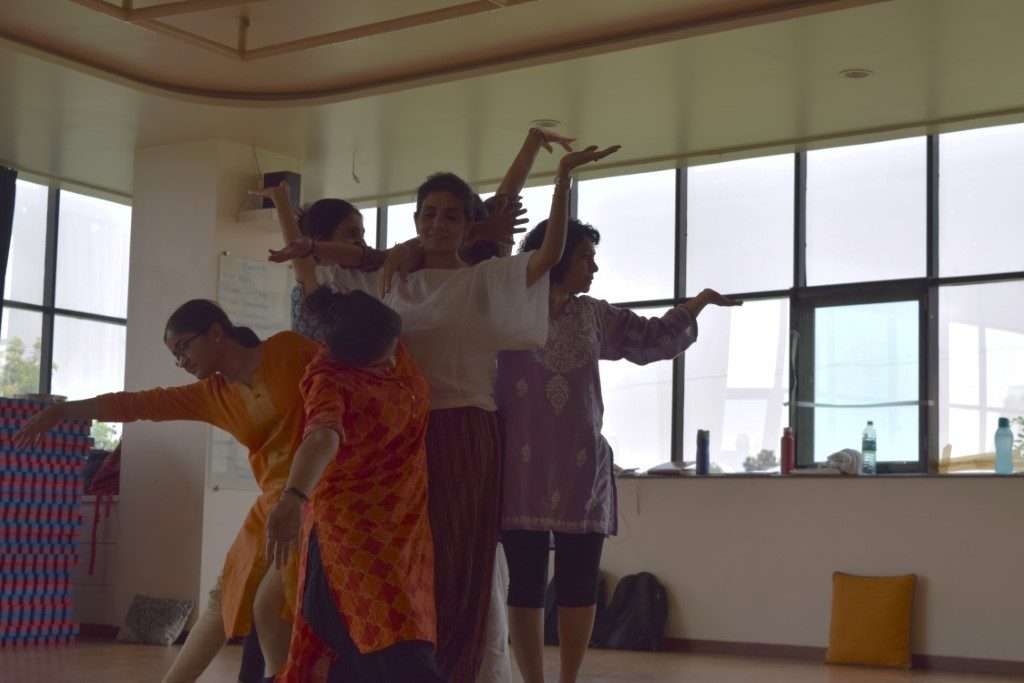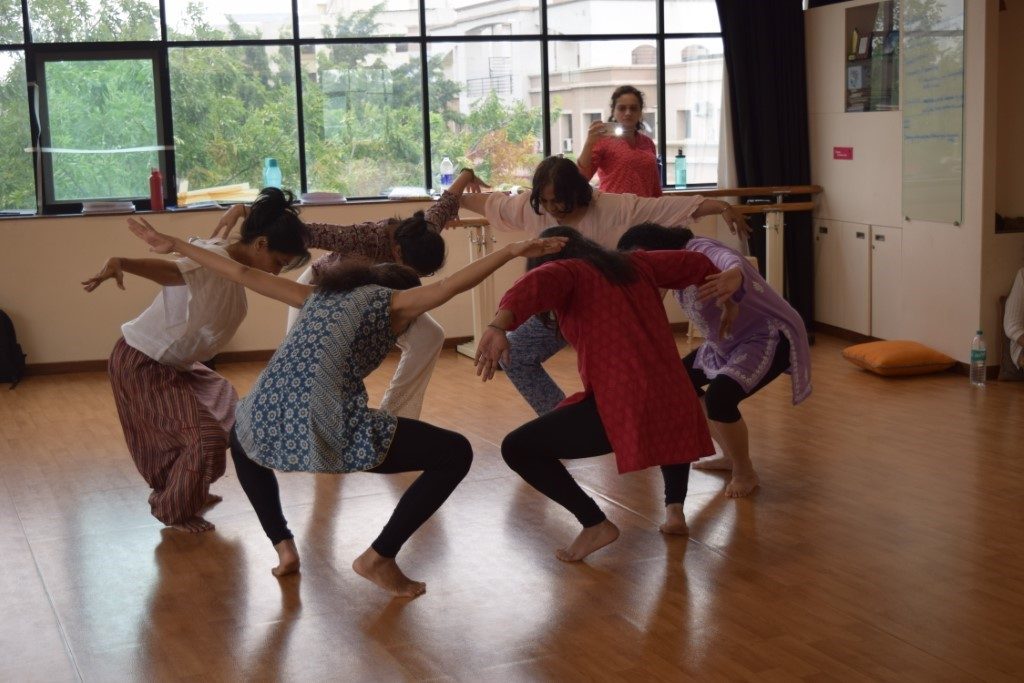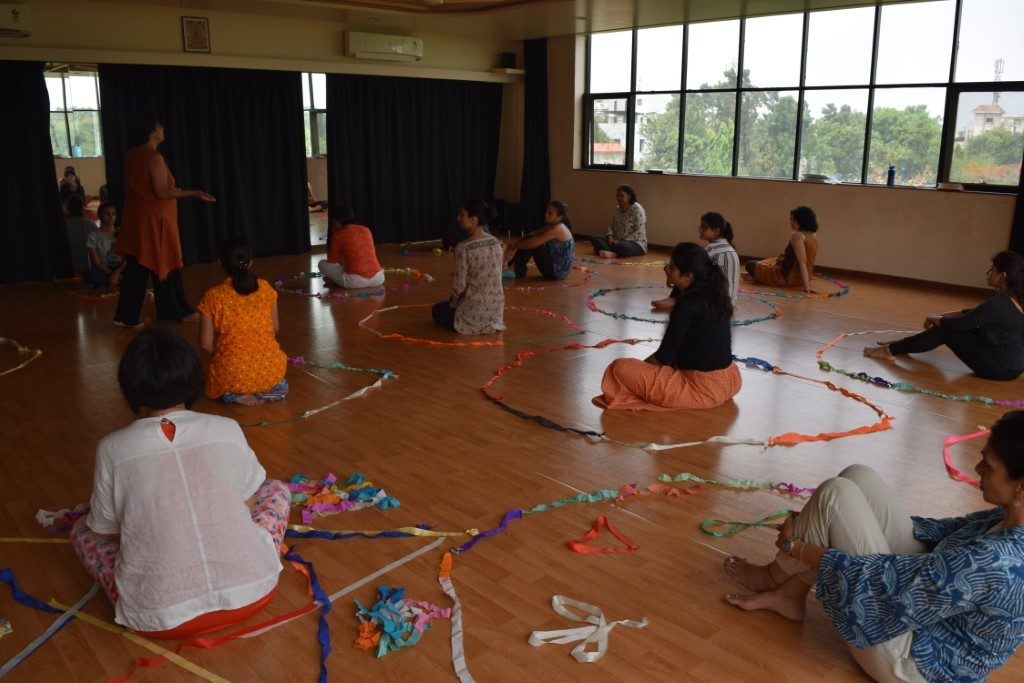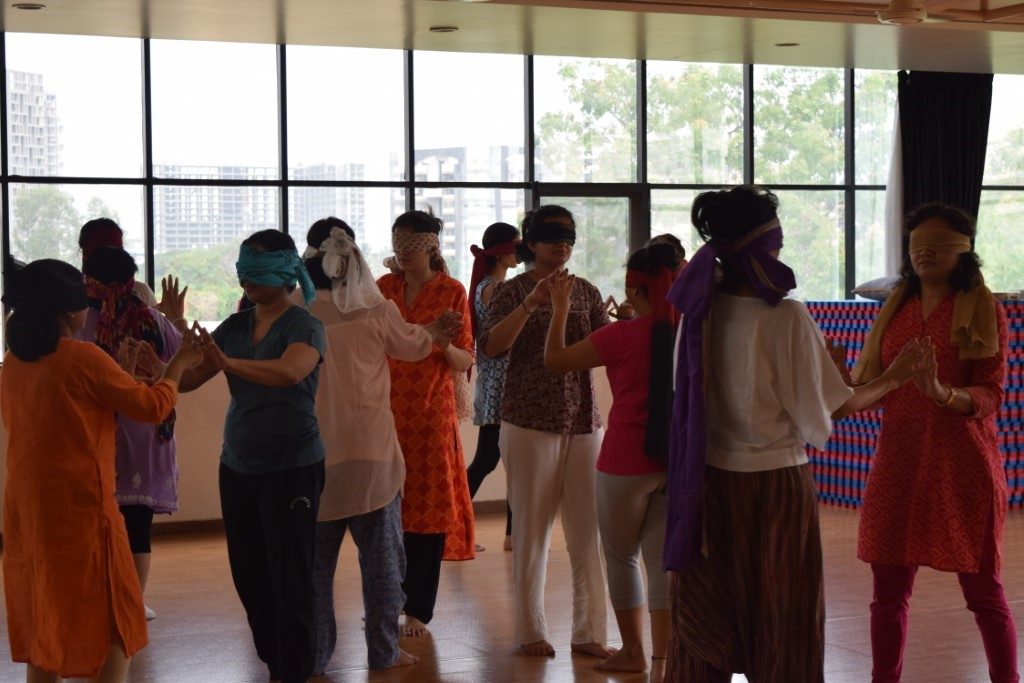LILA: Let us begin with an introduction to Creative Movement Therapy that you have adapted in your work. Please tell us a little about what it is and how you came to adapt it to the Indian context?
Tripura Kashyap: Movement therapy, I would say, is like body psychotherapy. It involves movement activities and games to help people express repressed emotions and feelings, which they are not otherwise able to articulate. Movement therapy is used in different kinds of contexts where people have a disturbed body-mind connection. For instance, the body is really neglected in our education system, especially in special education, where it is very necessary to work with children’s bodies. So our mission has been to take the body into schools or educational systems, wherever people are learning something, or even NGOs, to get people to start expressing through the body.

LILA: That is right. There is no participation of the body in education, as most often, children have to sit and look into their books to study. This has been known to have undesirable consequences to their health…
Tripura Kashyap: Exactly. I find this very unnatural. Children are not meant to sit for so long; they are supposed to move. I have adapted something in India called ‘dance in education’. On the one hand, the idea is to create a space for the holistic development of the child – like building confidence, emotional expression, trust in the people around you, etc. On the other hand, we are also looking at how movement can be used to teach science, maths, and other subjects. You can actually teach all this through the body. For instance, I realise that when you draw a triangle on the board, some kids, especially the younger ones have problem drawing it on paper. But if you actually make them walk in a triangle, they immediately understand what it is because they’re experiencing it with the body. Same with solids, liquids, gases – you can convert all of them into movement games and children remember these things much better.
As part of this, I also conduct workshops for academic subject teachers. Their personalities are often so closed that whatever they teach can get really monotonous, because they’ve not worked on their body, or the gestures that they can use while teaching. In that sense, these workshops help with the personality development of the teacher, to teach in a much more dynamic way.
LILA: You are also developing workshops to help people communicate with their body and develop a language with it. Can you tell us a little bit about that?
Tripura Kashyap: I believe that anyone can dance, and that movement is integral to our body. That’s what we first did in our mother’s womb, with kicks and summersaults; we kind of expanded, contracted. In the womb we were very experimental and playful with movement because we didn’t have any rules and regulations in our head. But as we grow up, especially in the digital age, all our movement is reduced to the fingertips. So even if movement is there, it is very mechanical – you go to the office, you go to school, you sit. It’s all very predictable and done in an ad nauseam way. So, whenever I do any workshop, with children or with adults, the central question is how can we reclaim our body to be expressive and communicative?
If you look at all our ancient societies, dance was so much a part of our culture. You had all these circle dancers, where the choreographers were the fishermen and farmers. These were ordinary people who created dance. I feel like when I do these workshops, in a way it’s really like going back to those societies when movement was not about performance, but about getting in touch with your body and using it as an expressive tool. So improvisation is a big part of our work. For example I would ask some of my clients to move, act and breathe the way they were feeling in the moment, and so much of their emotions would explode, because it was really the body that was speaking. I think to a large extent we can speak a lot of untruth through words, because we are so used to it and we can hide behind those words, but with the body it’s a difficult thing to lie.

LILA: While dance becomes a way to reconnect with our body, it is also a way to connect with the ‘other’, through touch-improvisation and generally dancing together. How can we understand intimacy through dance and the nuanced dynamics involved in such a practice?
Tripura Kashyap: In India we don’t really have a sense of personal space, even though it is so important. Even in my workshops, when we talk about this, people don’t understand what it is. There are so many cases of sexual harassment that happen, but women don’t know how to deal with it. They don’t always know how to say no, or be strong with their bodies. So what I do is, I tell people that the personal space around your body is like a bubble, which is your reach space. It’s called the kinesphere. This bubble shrinks and expands according to the people you are with. I did a workshop at NIIT in Greater Noida, where the idea was to see how these women could assert themselves. We started by working with the idea of personal space. I gave them colourful ribbons to put around themselves that marked their personal zones – some made bigger circles, some made smaller ones. But it was really beautiful that they realised that there was something like a personal zone. This led to further discussions about what they imagined was the texture of your personal space – was it like a wall? Was it permeable? Would they let people in easily? Is it elastic? We went onto experiments of allowing people in, and also pushing them out. It was interesting to see how uncomfortable women were to say no. I had to force one group to keep pushing the other till they really got angry and were able to stop people from entering their space. It sounds theatrical, but this is what it takes to make them realise what personal space is.

Apart from this personal space you also have the body boundary, where you know where the body begins and where it ends. I think this kind of consciousness, which is not there at all, is also very important. Because interactions between bodies happen at a very non-verbal level, there is so much confusion about it. Another problem is that no one is really working with men. I feel like even in dance therapy or art therapy fields, there are so many women, but there are no male therapists. I’m hoping in movement therapy we get more male therapists to would go and work with these people.
On the other hand, I think movement is wonderful because touch, according to many neurological studies, is very important for brain development. It is also very important for the development of the body, emotional development, and attachment. In many of the groups that I work with, I slowly and gradually bring in activities involving touch, after we have worked together for a while. I talk to them about sixteen different kinds of touches, as categorised by psychotherapists, and we actually study them – like ritualistic touch, task oriented touch, etc. So I feel when people try them, and understand the difference between one kind of touch and another, they see start to feel safer with it.

LILA: Do you think this kind of training can or should be introduced to a child at the school-level also, for it to become a regular, basic aspect of life?
TK: Yes, you can. In fact, I think you should start with children when they are 6 or so, to make them aware that this is my body and it cannot be invaded by others, which can also help avoid sexual abuse amongst children. So I think it’s very important to make children aware of their bodies, and that’s why dance in education is so important.
LILA: The entertainment market is flooded with material that does not offer any food for thought. Children watch it and are not aware of issues around gender, caste, class, race and many others. Is there a way to bring awareness and transformation to the larger public in this regard, especially as we talk about dance as a medium of expression, communication, and connection?
Tripura Kashyap: It all comes back to body image. You get a sense of your own body either kinaesthetically, or through what people tell you – you’re too fat, you’re too thin – or when you are looking at these kinds of media images and you compare your body to them. Most times, I’ve noticed, women do not have a positive body image at all, no matter how beautiful they are, because they constantly compare themselves to these typecast, stereotypical images. This also leads to a lot of unhappiness.
In some of my workshops, I ask women to draw their own bodies on a piece of paper. It’s interesting to see that the image they make is never the same as what they look. Sometimes, just to have fun, I get them to draw caricatures of themselves – like, if you think your nose is long, draw it really long; if you think your hips are big, draw them really huge. In a way, this is a negative way of looking at the body, but the outcome is very positive. Once they do that, they sit with each other and make something called the body poem, where they have to label that caricature – like ‘stick-thin legs’ or ‘Pinocchio nose’. They have to then enact that poem with their bodies. By the end of this exercise, they’re all laughing at themselves, and they realise that the shape, size, colour, of the body is not important. It’s really about who you are inside that matters. So I think one needs to design these kinds of transformation experiences, not just for adults, but also for kids. For teenagers especially, in their adolescence, who have such body image issues.

